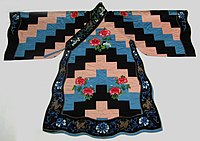Shuitianyi
| Shuitianyi | |||||||
|---|---|---|---|---|---|---|---|
 A style of shuitianyi used as atheatrical robefor a female Daoist priest (front view), 18th century. | |||||||
 Back view | |||||||
| Chinese | Thủy điền y | ||||||
| Literal meaning | "Paddy field garment" or "rice-paddy robe" | ||||||
| |||||||
Shuitianyi(Chinese:Thủy điền y), also known as “paddy field garment”, "Shuitian clothing", or "rice-paddy robe",[1]is a non-religiousChinese patchworkgown which was made and worn by women inChinaduring theMing dynastyandQing dynasty;it was made by using many pieces of fabric sewn together (similar toChinese patchwork); the clothing reflected the era's tendency towards fashion novelty during theMing dynasty.[2][3][4][5]
Origins and Development[edit]
Theshuitianyiis a popular, but rare fashion phenomenon, which appeared in the middle and the lateMing dynastyand remained popular in theQing dynasty.[5][6]Theshuitianyimay have originally originated from poor people, who would use whatever leftover clothing they would have at hand for saving purposes, and was initially only popular among poor women.[5]Its origins may have been inspired by Buddhist robes,[4]theKasayaorBaina,which was made when monks would make clothes out of a variety of useless clothes.[5]It was later adopted by aristocratic women duringMing dynastywho found it beautiful, and they began to cut cloth (even from entire brocade) voluntarily into a design shape and sew it into an aristocratic form of the shuitianyi.[5]While theshuitianyiwas a popular form of fashion for women in theMing dynasty,men during this era would also wearbaina clothing.[5]
Other versions[edit]
Baijiayi[edit]
A version of theshuitianyiworn by children is calledbaijiayi.[5]
Sanse dao beixin[edit]
InBeijing opera,the shuitianyi is worn as acostumecalledsanse daobeixin(Chinese:Tam sắc đạo bối tâm;pinyin:sānsè dào bèixīn;lit.'Three color Daoist vest'). It originates from Buddhist clothing and represents the ragged clothing ofBuddha.[7]: 177–178
Thesanse dao beixinis characterized by a diamond-shaped pattern which is created through patchwork.[7]: 177 It can be used by actors who perform as male or female monks and asTaoistcharacters.[7]: 177 While both male and female roles used it; however, there are differences between the man's and woman'ssanse dao beixin.[7]: 177
The female version looks like a knee-lengthpifengas it features a centre-front opening and a collar band which ends at the mid-chest level; however, it differs from the pifeng due to the absence of sleeves.[note 1][7]: 177
The man's version is floor-length and the collar band has a straight lower edge; it is also tied with a sash without the back of the garment being caught in the sash, which is the manner monks wear their vest.[7]: 177 When male monks characters wear it, it indicates that they have outstanding martial arts skills.[7]: 177
See also[edit]
Notes[edit]
References[edit]
- ^"Theatrical robe for a female Daoist priest 18th century".www.metmuseum.org.Retrieved2021-12-23.
- ^Hanson, Marin F (2014).""One Hundred Good Wishes Quilts": Expressions of Cross-Cultural Communication ".Uncoverings.35:69–89 – via Art Index (H.W. Wilson).
- ^"Costume in the Ming Dynasty - - China Style".www.chinastyle.cn.Retrieved2021-02-06.
- ^abFinnane, Antonia (2008).Changing clothes in China: fashion, history, nation.New York: Columbia University Press. pp. 48–49.ISBN978-0-231-14350-9.OCLC84903948.
- ^abcdefgYin, Zhihong (2019)."Study on the Evolution and Development of Baina Clothing to Shuitian Clothing in the Ming and Qing Dynasties".Proceedings of the 3rd International Conference on Art Studies: Science, Experience, Education (ICASSEE 2019).Vol. 368. Atlantis Press. pp. 315–318.doi:10.2991/icassee-19.2019.65.ISBN978-94-6252-837-6.
{{cite book}}:|journal=ignored (help) - ^Gao, Yingpei (2018)."Application of Patchwork Art Form in Traditional Costumes: A Case Study of Baijia Clothes".Journal of Landscape Research.10:98–100 – via ProQuest.
- ^abcdefgBonds, Alexandra B. (2008).Beijing opera costumes: the visual communication of character and culture.Honolulu: University of Hawaiʻi Press.ISBN978-1-4356-6584-2.OCLC256864936.
